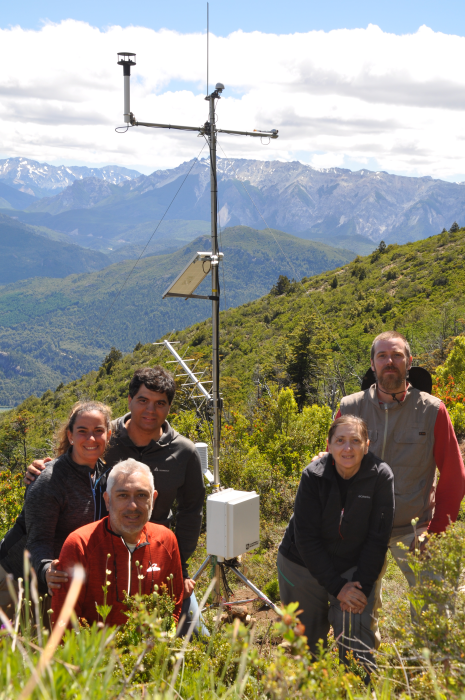



Introduction
The Andes Mountains of Argentina are home to a rich and diverse group of organic life. Climate change is affecting the mountainous regions of the world and may endanger these species. The Biometeorology team of the Department of Atmospheric and Oceanic Sciences of the University of Buenos Aires (UBA) is studying the conditions that allow this life to exist. Acquired measurements include air temperature and relative humidity, global radiation, leaf wetness, and wind speed and direction. Due to the rugged and unforgiving nature of the Andean region, the UBA selected Campbell Scientific to provide essential equipment for this project including a CR300 datalogger, TX321 GOES transmitter, CM110 tripod with duckbill anchor kit, ENC16/18 enclosure, HMP155A temperature and relative humidity sensor, and a WindSonic4 2-D wind sensor.
Biological Aerosols
Understanding the transport of biological aerosols is important to the future of climate change and changes in wildlife in the Andes. Aerosols are small, solid or liquid particles that are distributed into the air. A biological aerosol is an aerosol whose origin is from a microbial, plant, or animal. Consisting of living or dead pathogenic or nonpathogenic bacteria, fungi, and other organisms, bioaerosols have an impact on the environments around them. Measuring the dispersion of these biological aerosols throughout the Andes can have a profound impact on wildlife conservation and monitoring climate change in the future.
Importance of Aerosols to Wildlife
The different forms of wildlife in the Andes rely on biological aerosols, such as pollen and other particles, to thrive. Changes in weather patterns over time alter the dispersion of these aerosols, thus affecting the wildlife and overall climate in the Patagonia region. Identifying which weather conditions provide the most effective dispersion of biological aerosols was essential to planning their measurement. With greater understanding of how the bioaerosols disperse, scientists can help promote tree and wildlife reproduction within the region.
Pollen is essential to the fertilization of flowering plants. In the Andean forest, pollen assists in the natural cycle that trees follow, which allows for so many species to thrive. Pollen is light and dry, which makes it extremely susceptible to weather conditions. Measuring wind speed and direction can help identify trends for plant fertilization. Researchers use these measurements to determine how far pollen can travel. Relative humidity measurements can also offer actionable insight, as moisture in the air can weigh pollen down and reduce seed production.
Acquiring data in the Andes presents a unique set of challenges. These measurements are obtained in a remote sector of South America’s longest mountain range. The Southern Andes hosts a humid mountain climate. Extreme conditions are common due to high winds, dramatic temperature changes, flash rain, and snow.
Along with extreme weather, geological barriers make it difficult for researchers to operate in the Andes. Much of the Andean forests are remote and inaccessible to entry points such as roads and trails. To maximize options for the placement of automated weather stations, researchers need equipment that can be easily transported and assembled on unstable terrain. For this reason, Campbell Scientific’s CM110 tripod with duckbill anchor kit was a most suitable choice. It is also crucial that the equipment has low power needs and can be effectively powered by a portable solar panel. The reputation of Campbell Scientific equipment to operate in harsh conditions made their equipment the ideal choice for measurement sensors in this environment, including the HMP155A air temperature and relative humidity sensor and the WindSonic4 sonic wind sensor, which features zero moving parts.
Conclusion
Learning more about and measuring the dispersion of biological aerosols in different weather conditions was of the utmost importance to the Biometeorology team of the Department of Atmospheric and Oceanic Sciences of UBA. Harsh environments and the need for precise measurements made the rugged Campbell Scientific instruments a perfect fit; they are durable enough to complete the task and will also be pivotal in helping scientists know the relevance of meteorology for tree reproduction and the spread of forest pests and diseases.